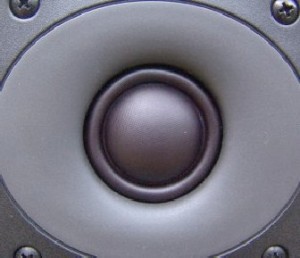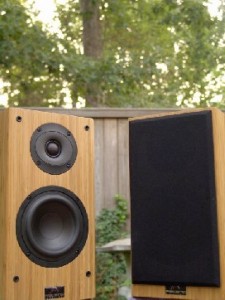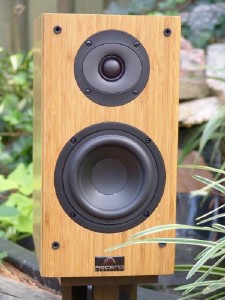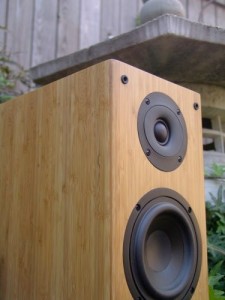Ascend Acoustics took the consumer direct market by storm at the turn of this century with a brilliant, yet subtle two way stand mount loudspeaker dubbed the CBM-170. Founder and owner, David Fabrikant, took a path rarely traveled with his company. Instead of tipping the scales of production costs in favor of cosmetic appeal, David chose to invest his cash in quality components that make for an excellent transducer. The results speak for themselves; Soundstage! magazine gave the CBM-170 their coveted 2003 Product of the Year award along with the Budget Leader award the following year in 2004. The CBM-170 is still one of the highest rated loudspeakers at audioreview.com, a website which gives every audio enthusiast the opportunity to rate audio products. At the time of this review, there are currently 88 consumer reviews that average an astounding 4.92 score out of a possible perfect 5. That’s the kinda approval rating politician’s dream of folks. Even our own Clarke Robinson found himself smitten by the larger CMT-340 SE towers earlier this year.Shortly after Clarke’s review, as spring gave way to summer – Mr. Fabrikant delivered a bombshell. He announced the arrival of the Sierra-1 – a new two-way stand mount loudspeaker designed to break barriers amid the crowded and highly contested $1,000 market.
Specifications:
- Typical In-Room Frequency Response: 39Hz -22kHz ± 3dB
- In-Room Sensitivity: 87dB @ 1 watt / 1 meter
- Frequency Response (Anechoic): 44Hz -22kHz ± 3dB
- Sensitivity (Anechoic): 86.5dB @ 1 watt / 1 meter
- Average Impedance: 8 ohms
- Minimum Recommended Power: 45 watts
- Maximum Continuous Power*: 200 watts Maximum
- Short Term Peak Power*: 400 watts
- Cabinet: Exclusive V-LAM™ construction featuring vertically laminated bamboo. Bass reflex via flared rear port tube
- Dimensions: H x W x D** 14.25″ x 7.5″ x 10.5″ Weight (each): 20 lbs each
- Shipping Weight: (pair) 43 lbs per pair
- Tweeter: (1) 26mm high-definition soft dome tweeter w/ integrated elastomer wave guide, wide surround, low-viscosity magnetic fluid cooling, pole-piece damping chamber. Fully manufactured by SEAS of Norway
- Woofer: (1) proprietary 5.25” long throw mineral-filled polypropylene cone, non-resonant cast aluminum frame, copper shorting rings, low-inductance motor assembly, vented polepiece and vented spider.
- Connectors: (2) gold plated all metal 5 way binding posts. Inserts: (1) ¼” x 20 inserts for mounting to stands Warranty: 7 year parts and labor
- Price: $798.00 (Natural Bamboo) $858 (Piano Black)
Ascend Acoustics Sierra-1 review
Design and Build
Truly a labor of love’, the Sierra 1 is the product of a massive development effort which spanned well over four years, resulting in what may be the most “tricked out” speaker currently available under the 1k mark. The most stand-out character of the Sierra-1 is its long and slender cab that is constructed entirely of bamboo. That’s right, bamboo. Originally inspired by a piece of furniture, the cabinet is made up of vertically laminated bamboo panels. Why bamboo? Although technically part of the Poaceae (flowering plant / grass) family, when treated, bamboo is both extremely light and durable. Its strength, resistance to harsh climates, and subsequent abundance has made it a top choice for construction material throughout the globe. David Fabrikant found that these rigid attributes, when used as a speaker cabinet, dramatically reduces energy loss and resonance on a level equivalent to a 3 inch thick slab of MDF. The manufacturing process is not easy – which explains why the Sierra 1 is currently one of the only affordable high performance stereo loudspeakers made of bamboo in North America.
Much like other Ascend products, none of the parts used in the Sierra 1 can be purchased off the shelf. The tweeter is a custom 1” soft dome from SEAS and features a unique semi wave guide insert to help maintain good off axis response, to reduce diffraction, and to absorb stray high frequencies.
As it turns out however, it’s the custom 5.25” long throw woofer that proved to be the greatest technical challenge during the development of the Sierra 1. The woofer needed to deliver high excursion all the while maintaining a linear presentation which would result in a clean and artifact free midrange. This means that the cone had to have enough mass (thickness) to reproduce deep bass yet also needed to be physically small and light enough to keep distortion and resonance to an absolute minimum. It also had to compliment the cabinet and tweeter perfectly. Most of all, it had to match the desired performance at a very affordable price. Unwilling to make an easy compromise, years were spent developing a woofer that could get all of those elements right. The result is a woofer with a typical in room frequency response that digs all the way down to the upper 30hz range at its -3db point.
Yet, at the end of the day, there is something to be said for a product that is reliable and maintains consistent build quality. Ordering products direct typically means you will be unable to get an audition before handing over your hard earned coin.
While most companies offer a 30 day trial period, as does Ascend, there is a significant layer of comfort added to the equation when you know, without a doubt, that your order will arrive free of manufacturing errors. Ascend Acoustics takes this to a whole other level by hand assembling every left/right pair of Sierra 1’s and matching them within exacting tolerances. When you purchase a new set of Sierra-1’s – you receive a printout of its actual production line on-axis frequency response which is confirmed by serial number. Covered by a lengthy 7 year warranty – this is the kind of confidence and focus on consistency you will rarely encounter anywhere in affordable high end audio.
First Impressions and Set Up
Weighing 20lbs a piece and measuring 14 inches high, 7.5 inches wide, and 10.5 inches deep, the Sierra 1 are sizable enough speakers to warrant a solid and stable foundation. Wall mounting is not optional. While many larger monitors have a tendency to attract the eyes attention– I never found the Sierra 1’s to cause any feng shui unrest. In fact, I find the subtle and layered look of bamboo to be very pleasing on the eyes. As a bonus to their handsome looks and sturdy build – you also get a nice set of 5 way binding posts.
With an easy 8 ohm load and a respectable sensitivity of 87db, the Sierra 1 lends itself to a wide variety of amplification choices. The bulk of my listening was conducted on the over achieving Red Wine Signature 30 battery powered amplifier, and the surprisingly capable Harman Kardon 3470 – a receiver that I usually use as an emergency back-up when I need something to process and amplify a signal during periods of electronics limbo. Many Ascend customers pair their speakers with stereo or surround receivers, making the Harman Kardon an ideal match for this evaluation.
Setting up the Sierra 1’s was a breeze. With my listening position roughly six feet from the speakers, I set the speakers five feet apart from one another with slight toe in. I found that the Sierra 1’s presentation began to beam whenever the drivers faced near or directly at my listening position. Like most rear ported speakers, you will need to give the Sierra 1’s a bit of breathing room. I’d heavily recommend giving them at least one foot of space away from any surrounding boundaries.
The Sound of Sierra-1
Smooth, Detailed, Coherent, Musical are just a few words that automatically sprang to mind when the music began to flow.
I’ve noticed a growing trend in high end audio lately; more and more speakers are being voiced for neutrality, creating a sound that never emphasizes any one particular frequency or aspect of reproduction. Traditionally in our hobby, such neutrality often comes at the expense of rendering good music that has not been recorded well to be un-listenable. While the Sierra 1’s fall right in line with this new movement, they manage to deliver the goods without alienating less than perfect recordings, which is music to my ears – literally.
In some respects, the Sierra-1’s presentation shares a number of similarities with the Tyler Acoustic Linbrook Super Mini that I reviewed in May. Both render a presentation that is even keeled with a high end that is neither laid back or aggressive. The critical differences that separate the two, physical prowess aside, boils down to resolution and tone – more on that later. Meanwhile, I will say the same thing about the Ascend Sierra 1 as I did about the Tyler’s – balance and coherence is truly the name of their game. In fact, I would go on a limb to say that the Sierra 1 is the most electronically accurate speaker I’ve heard at and under the 1k range – something I don’t say lightly as plenty of excellent speakers have entered these walls.
Like most monitors, the Sierra-1’s render a very wide sound-stage with exceptional left to right separation – placing instruments in space very convincingly all the while delivering solid focus between the speakers. This is not so surprising, after all – this is what monitors do so well and is why so many tend to prefer them over floor standing transducers. What is surprising however, is their ability to project sound well into rooms both big and small – rendering a great sense of scale while maintaining good control and composure, even at louder volumes. Do you like to rock and roll? Want to experience the explosion of energy during the crescendo of Tchaikvosky’s 1812 overture? Have at it! The Sierra-1’s power handling and distortion free dynamic range is exceptional for a stand mount monitor. These speakers took everything I threw their way, from hard hitting rock and electronic to large scale big band jazz and symphony without a hint of strain or compression.
As impressive as high output capabilities may be, it is rare for yours truly to ever surf those waters. In truth, I usually end up crying mercy well before the system does. Instead, I am a hopeless romantic (some just say I’m hopeless) that enjoys softer late night listening sessions meaning that my ears tend to perk in the direction of components that are able to render great low level resolution. The Sierra 1’s do not disappoint in this regard, and while they do lose an ever so slight bit of sparkle on top – they still deliver all the goods that leave me content and in my chair. Even at whisper volumes, Diana Krall’s “Live in Paris” sounded expansive and alive. Nirvana’s “Un-plugged” album retained its atmosphere and edge.
Overall, one of the main assets of the Sierra-1 rests in its high frequency presentation. To these ears, its custom tweeter captures a good amount of performance of the venerable and much more expensive Seas Excel Millennium (which happens to be one of my favorite soft domes). The presentation, although slightly forward, is incredibly smooth and rich – giving off gobs of air supported by all the detail you could want. Unlike many highly detailed monitors, the tweeter never bombarded my ears with an over abundance of information. Like the Seas Excel driver – the tweeter used in the Sierra 1 has found a harmonic balance between a passive and aggressive presentation. Guitars had just the right amount of bite, attack, and decay. Horns had great shout without honk, strings had great pluck, and female vocals extended well without an artificial lisp.
Supporting the high end is a neutral mid-range that has little distinguishable character of its own. You could say – it just is. The Sierra 1’s mid-range is extremely quick, detailed and clean. It is so clean that it may take some listeners time to adjust to this type of sound.
Anchoring the entire presentation is solid bass performance can make competing small stand mounts and towers blush. Arguably the star of the show; the Sierra-one’s custom woofer captures palpable weight and impact without compromising tonal neutrality. While the bass may not be as fast as an electrostatic speaker, make no mistake, it is by no means slow. It never once showed signs of being flustered by complex bass riffs, passing the high paced finger bass notes on Holy Cole’s latest self titled album with flying colors. With exceptional power handling and a somewhat thick character; the bass performance lends itself well to genres of music many audiophile speakers fall short on. Fans of electronic, hip hop, r&b, pop and modern rock rejoice! I had a blast rockin’ to Incubus, The Smashing Pumpkins, Dj Tiesto, Mos Def – just to name a few. As I listened, I kept thinking;
Speakers this inexpensive have no right to have bass that is this quick, full, deep, and punchy. Folks using the Sierra 1 for purely two-channel playback may find no need for any additional bottom end.
The Compromise
Those of you familiar with my previous reviews know that I am a firm believer in nothing being without mentionable fault, especially when it comes to budget hi-fi. The Sierra-1 is of no exception, and while the above review has come across as a bona-fide rave, there aspects of their performance to be aware of. Getting right to it;
Even though the Sierra-one maintains a distortion free sound at higher output levels, I found the speakers to lose a bit of their soundstage and beam as the volume increased. Their tendency to beam quickly induced listener fatigue, which made it very difficult to listen for extended periods of time at higher volumes. I found it much less tolerable with acoustic, jazz, and classical music than I did with more modern and often synthesized music.
Many believe that a ruler flat response is the gateway towards the true path of recreating an honest and uncolored presentation. Far be it from me to jump into the fray of that tireless argument, I nonetheless have to admit that I have a liking for mid-range that is more blossomed and defined. Clean and detailed as the mid-range is, I found it a bit thin causing the presentation to sometimes sound like a real good tweeter and woofer at work with no buffer in-between.
When you come across a rare gem like the Sierra-1, a speaker that can do so much right at such a low entry point – one is forced to ask what gains you can expect when stepping into pricier territory. While that answer can vary, when I compared the Sierra-1 directly to more expensive speakers such as the Mark and Daniel Topaz ($1800), Tyler Acoustic Linbrook Super Mini ($1200), and the Totem Acoustic Staff ($1700), it became immediately apparent that those gains come in the form of refinement, resolution, and tone. While tone is an aspect of presentation that I am most critical on, it is also important to remember that it is one of the more difficult elements to define as it is a reference point that is intensely personal. In most case scenarios, the reference of tone is nothing more than a memory that your brain associates with live music you’ve experienced in the past – which is significantly influenced by the atmosphere of the event, the acoustics of the venue, along with the instrument type, build, tune, and position. While the Sierra-1 has respectable tone that surpasses many speakers I’ve heard in and well above its price range, I felt it still lacked that last ounce of layer and personal touch that really draws me into the music. While there is a good chance that these results are also a function of the electronics used with the Sierra-1, just as in the real world – there is only so much one can have access to.
Conclusion
What more is there to say? Even in the heavily contested $1000 price-point market, the Sierra-1 stands out as a wonderful accomplishment. There are few other speakers in this range that can cover the frequency extremes with such versatile ease. They give you great detail, air, tout and quick bass, along with a sound-stage that really give the budget minded audiophile a window into what high fidelity is all about. What the Sierra 1 does well easily overshadows the very few of its shortcomings. Wrap it all up in a nice package with a 7 year warranty along with a 30 day trial period and I have to ask – what are you waiting for? The Sierra-1 gets my highest recommendation for any budget conscious enthusiast.
Source:
- Arcam Diva 62 ; E-MU 1212M
Integrated Amp:
- Red Wine Audio Signature 30 , Harman Kardon 3470
Cables:
- Totem Acoustic Sinew interconnect ;
- Totem Acoustic “Tres” speaker cable;
- Zu Cable “birth” power cable
Room Treatments:
- Eighth Nerve “Adapt” Triangles ;
- GIK Acoustics 242 Panels
 from affordableaudio, By Zero
from affordableaudio, By Zero





Excellent review. I have a pair of Tyler Acoustics Reference Monitors and love them. Ty Lashbrook is a treasure. My main listening system is all tube (Jolida amp & CD player, VPI with Benz Micro L2 cart, Zu cables and interconnects , tube phono-pre). I’m looking to replace a pair of Fortura 10’Heil Air Transformer Speakers in my master suite (20 x 12). system consist of 100 watt Sony AVR and DVD player . Bed sits at rear wall, system at front wall (speakers 3′ in front of window each side front wall). Chairs placed at 5′ and 10′ from system each side wall. Medium – large room, speaker placement not constrained. Replacement speaker being considered – Sierra 1 ( on stands) and Tekton Lore S/Lore. I’ prefer and will continue to support the small independent craftsman. Excellent ratings and reviews both speakers. I’m a music lover who likes to be engaged when listening not analytical. The Sierra’s slightly less expense but a monitor that is said to perform like a floor stander. Both bass adequate without sub.
Reviews seem to indicate both have similar sonic character. May bring both in house if sonically that close. Are they? Which of the two do you consider the better performance/value buy. Cost is close( within $200.00)? Your input is appreciated.